
Related essays
Formation 1
Formation 2
Formation 3
Continuing the discussion of the formation of human societies, it may be useful to consider a fairly well defined circumstance in which humans might find themselves, and consider possible survival strategies that they might use. We might construct a simple model of a circumstance in which humans might have found themselves, and see what might happen.
1. Nomadic Individuals
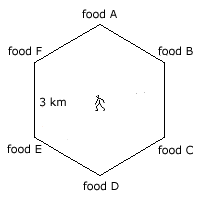 Humans may be imagined to live in a flat area where six different kinds of food are to be found at the vertices of a regular hexagon with a side length of 3 km. Each of these foods supplies the same amount of energy as the others, and takes as long to collect and to consume. Humans need to eat equal amounts of each food per day, in no particular order, if they are to maintain a balanced diet, and without any particular food they will suffer from a disease of its deficiency. Each food occurs extremely abundantly at each vertex of the hexagon. The foods may be thought of as apples, oranges, nuts, roots, shellfish, and the like.
Humans may be imagined to live in a flat area where six different kinds of food are to be found at the vertices of a regular hexagon with a side length of 3 km. Each of these foods supplies the same amount of energy as the others, and takes as long to collect and to consume. Humans need to eat equal amounts of each food per day, in no particular order, if they are to maintain a balanced diet, and without any particular food they will suffer from a disease of its deficiency. Each food occurs extremely abundantly at each vertex of the hexagon. The foods may be thought of as apples, oranges, nuts, roots, shellfish, and the like.
Humans are further imagined to use energy at a constant rate, regardless of what they are doing. They also do not sleep. And they are able to walk at 1.5 km/hr. And they are able to collect sufficient food for their daily needs in half an hour at each vertex. They either eat this food as they collect it, or they carry it with them and eat it as they go. The foods they gather are neither heavy nor bulky, and they can carry any number of them with them if they so choose.
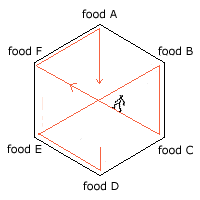 Since there is no particular order in which food needs to be collected and eaten, individual humans may wander randomly from one vertex of the hexagon to another, collecting and eating food as their inclination takes them. If one individual chose to eat food D first, and then food E, then food B, C, F and A, it requires a daily journey of total length 27 km, and 27/1.5 or 18 hours duration. Given a total of 3 hours are needed to collect all food needed at each vertex, this individual will be busy for 21 hours a day, and idle for 3 hours - an idleness of 3/24 or 0.125.
Since there is no particular order in which food needs to be collected and eaten, individual humans may wander randomly from one vertex of the hexagon to another, collecting and eating food as their inclination takes them. If one individual chose to eat food D first, and then food E, then food B, C, F and A, it requires a daily journey of total length 27 km, and 27/1.5 or 18 hours duration. Given a total of 3 hours are needed to collect all food needed at each vertex, this individual will be busy for 21 hours a day, and idle for 3 hours - an idleness of 3/24 or 0.125.
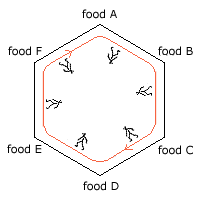 In this circumstance, the simplest expedient for any individual is to simply walk around the perimeter of the hexagon, gathering and eating food at each vertex. Given that there are 6 different foods, total collection time per day is 6 x 0.5 hrs, or 3 hours. And the time taken to walk at 1.5 km/hr around the entire perimeter of the hexagon is 12 hrs. Given that individual humans will alternate between walking and collecting, spending 3 hrs walking to the next vertex, then half an hour collecting and eating food, the total time taken to complete the full circuit will be 12 + 3 hours, or 15 hours. Their idleness will therefore be 9/24 or 0.375. During their idle time they will stop walking and collecting, and do something else.
In this circumstance, the simplest expedient for any individual is to simply walk around the perimeter of the hexagon, gathering and eating food at each vertex. Given that there are 6 different foods, total collection time per day is 6 x 0.5 hrs, or 3 hours. And the time taken to walk at 1.5 km/hr around the entire perimeter of the hexagon is 12 hrs. Given that individual humans will alternate between walking and collecting, spending 3 hrs walking to the next vertex, then half an hour collecting and eating food, the total time taken to complete the full circuit will be 12 + 3 hours, or 15 hours. Their idleness will therefore be 9/24 or 0.375. During their idle time they will stop walking and collecting, and do something else.
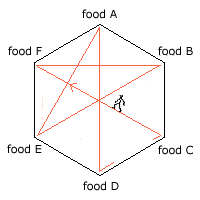 Conversely, one of the longest routes taking in each vertex of the hexagon might be one that began at C, proceeded to F, then B, E, A, and D - a distance of about 31.4 km, taking nearly 20.9 hours. With a further 3 hours needed to collect food, the total time an individual adopting this route would require per day would be 23.9 hours, with 0.1 hours per day idle. Such an individual would be busy the entire time. His idleness would be nearly zero.
Conversely, one of the longest routes taking in each vertex of the hexagon might be one that began at C, proceeded to F, then B, E, A, and D - a distance of about 31.4 km, taking nearly 20.9 hours. With a further 3 hours needed to collect food, the total time an individual adopting this route would require per day would be 23.9 hours, with 0.1 hours per day idle. Such an individual would be busy the entire time. His idleness would be nearly zero.
There may a variety of ways in which individual humans might meander around between the vertices of the heaxagon. But if conditions worsen - e.g. it rains and the ground gets muddy - with the result that humans can only walk at 1 km/hr rather than 1.5 km/hr, matters change. In this new circumstance, the longest route of 31.4 kms would require a 31.4 hrs of walking per day. And this isn't possible. Any individual who persisted in taking this long route would find that he failed to collect and eat sufficient food each day. He would slowly starve, and begin to suffer from a variety of deficiency diseases. Soon he would die. The same would be true of an individual who took a shorter 27 km route, which would now take 27 hours. It would take this individual 30 hours to collect and eat the food needed for one day of life. He also, continually wlaking and gathering food, would slowly starve, and eventually die. Only individuals taking the shortest route around the perimeter of the hexagon, a distance of 18 km, could manage this in 18 hours, and with an extra 3 hours required to gather food, this would be a total of 21 hours per day - giving an idleness of 3/24 or 0.125.
What this means is that when conditions worsen, humans become almost entirely constrained to walk around the perimeter of the hexagon. Wandering randomly from one vertex to another ceases to be a viable option. There is very little latitude - in the form of idle time - for any other route.
We now have a circumstances where individual nomadic humans walk around the perimeter of the hexagon, each collecting and eating food for themselves. But now that they are constrained to walk around the perimeter, rather than to meander around randomly from vertex to vertex, it follows that they become much more likely to encounter each other than beforehand. Humans are likely to find themselves walking in company with others around the hexagon, or else to encounter them passing in the opposite direction. They will increasingly find themselves in the company of other individuals who are engaged in the same activities as them.
And in this manner human society, at least in the form of humans simply living in company with others, will begin to take shape.
2. The Transition to Settled Trading Society
This account of the formation of human society begins with relatively leisured, self-supporting, nomadic individuals finding life getting harder, their idleness falling, and gradually adapting their behaviour in response to changing circumstances. Nomads found themselves busier, and increasingly moving in groups between food sources.
In the account thus far, hitherto meandering and leisured nomadic individuals become increasingly constrained to a busy routine existence, walking from one food source to the next. With idleness falling as circumstances continue to worsen, humans are on the lookout for ways to increase idleness through further changes of behaviour.
And one way that idleness can be theoretically increased is by shifting to a settled trading society. 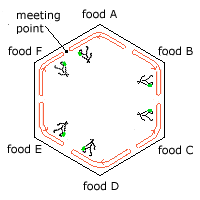 If 6 individuals walking around the perimeter of the hexagon were to each settle at one vertex of the hexagon, and gather all the food needed by 6 individuals, and meet up and trade this for food gathered by other individuals, another mode of existence emerges. Each individual collects together enough food for 3 individuals, and carries this to trade for food with another individual from an adjacent vertex, eating half his own needs en route, meeting half way between the two vertices. He then returns, collects food for another 3 individuals, eats half of his own needs while while walking to meet and trade with his neighbour from the other adjacent vertex. Each individual collects enough food for all, and this food is transported around the perimeter of the hexagon by trade, passed from hand to hand. Each individual becomes a sort of settled 'farmer' who gathers crops each day to take to 'market'. And a division of labour appears, in which each individual colllects only one food item.
If 6 individuals walking around the perimeter of the hexagon were to each settle at one vertex of the hexagon, and gather all the food needed by 6 individuals, and meet up and trade this for food gathered by other individuals, another mode of existence emerges. Each individual collects together enough food for 3 individuals, and carries this to trade for food with another individual from an adjacent vertex, eating half his own needs en route, meeting half way between the two vertices. He then returns, collects food for another 3 individuals, eats half of his own needs while while walking to meet and trade with his neighbour from the other adjacent vertex. Each individual collects enough food for all, and this food is transported around the perimeter of the hexagon by trade, passed from hand to hand. Each individual becomes a sort of settled 'farmer' who gathers crops each day to take to 'market'. And a division of labour appears, in which each individual colllects only one food item.
Since it takes half an hour to collect enough food for one person, it takes 3 hours to collect enough for 6 people. And during the process of going to meet and trade, each individual walks 6 km per day, which takes 6 hours. So each individual is busy 3 hours a day collecting food, and a further 6 hours per day carrying and trading food, making a total of 9 hours, and an idleness of 0.625 - a whopping increase on nomadic idleness of 0.125.
But it needs to be asked how the transformation from a nomadic life to such a settled trading existence might take place. Do all the participants have to agree to become traders, or might trading society emerge without any conscious planning? It may well be that trading societies will simply emerge from nomadic life without any planning or agreement, as a consequence of individual decisions. If two nomads are walking around the hexagon and meet, each will be carrying food the other wants, collected from the vertices they have just visited. If they exchange those foods they have for those foods they don't have, they will likely save each other the walk required to get these foods.
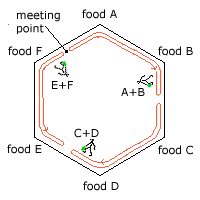 When a nomad carrying foods A and B meets a nomad carrying foods C and D, and exchange them, both will likely turn around and go back the way they came, to collect more of the food they have just given away, and are now short of. Both will proceed in these reversed paths until they encounter nomads carrying foods E and F, with whom they will again exchange foods, and again reverse the direction in which they are walking. In this manner, 3 nomads will become collectors and traders of foods A and B, C and D, and E and F respectively. And instead of walking all round the perimeter of the hexagon, each will walk a distance of 3 sides, or 12 km, taking 12 hours, and spending 3 hours collecting two kinds of food - a total of 15 hours, or an idleness of 0.375.
When a nomad carrying foods A and B meets a nomad carrying foods C and D, and exchange them, both will likely turn around and go back the way they came, to collect more of the food they have just given away, and are now short of. Both will proceed in these reversed paths until they encounter nomads carrying foods E and F, with whom they will again exchange foods, and again reverse the direction in which they are walking. In this manner, 3 nomads will become collectors and traders of foods A and B, C and D, and E and F respectively. And instead of walking all round the perimeter of the hexagon, each will walk a distance of 3 sides, or 12 km, taking 12 hours, and spending 3 hours collecting two kinds of food - a total of 15 hours, or an idleness of 0.375.
This arrangement is intermediate between nomadic life and collecting and trading in one food. It means that the transition from one to the other is accompanied by rising idleness at each stage. In this manner a trading society would emerge not as a conscious, planned choice by several individuals, but rather as a consequence of each individual following their own interests. Indeed, the individuals who interact in this way may be entirely unaware that they have collectively formed a primitive trading society.
4. Rules and regulations
When an individual starts collecting or carrying more food than he himself needs, he has effectively begun to work on behalf of everyone else. He has begun to work for society. In a society with 6 members, an individual will spend 5/6ths of his working time acting on behalf of others. He is a 'selfish' free agent who can do what he likes in his idle time, but is a dutiful member of society when he is busy working. He is a social being, acting on behalf of others, while he is busy. It follows that the busiest societies are made up of individuals who 'selflessly' act on behalf of others, even though it is actually in their own interest to do so. It also follows that in idle societies people will mostly be acting 'selfishly', doing what they themselves want to do. Independent wandering nomads, who collect and consume food for themselves, are entirely 'selfish': they are entirely concerned with their own interests. But when they join a human society, they have to learn to be 'unselfish' and to consider other people. They have to learn morality. And this is a new departure.
When each individual eventually finds himself habitually collecting one food item, and trading it for other foods, then each will be collecting food for all the others. The man who collects enough of food A for 6 individuals will exchange 5 units of food A for 1 unit each of foods B, C, D, E, and F. And the idleness of this primitive society will be much greater than that of independent nomadic life.
However, to keep the society going, each individual must collect enough food for 6 people, and meet up with their neighbours to exchange this for other food. And such meetings will likely occur at a regular place and time of day. Traders will come to have expectations of each other. If one person does not appear on time, the other may have to wait. And to be waiting is to be busy doing something, and not idle. To be forced to wait is to experience falling idleness. Thus the failure of one individual to perform his expected tasks, for whatever reason, will have effects on the idleness of other individuals. Each individual now has an interest in what other individuals are doing, and expectations of them. Which was not the case with independent nomads collecting food for themselves alone.
And the expectations each has of the others will become all the more intense if idleness continues to fall, and any return to independent nomadic life becomes impossible. Once individuals in a trading society have become fully dependent on each other, what began as hopes and expectations of each other gradually becomes demands and binding requirements, with penalties for non-compliance. What had begun as casual occasional trade gradually became serious regular business. What had once been optional had gradually become essential for survival. The failure of any individual to meet expectation threatened the survival of the whole society.
In these circumstances, the precise requirements of each individual would gradually become formalised into rules and regulations. Anyone who failed to observe these rules, for whatever reason, could expect to suffer some penalty. At worst, they may have been expelled from society, and forced to return to a non-viable nomadic life. Such expulsion would be, in effect, a death sentence. Customary trading habits would become mandatory. Each individual in the hexagonal community would be required to collect 6 items of food, and meet with others at an appointed place and time, on pain of punishment. If human society emerges out of necessity, it is out of equally dire necessity that its accompanying rules and regulations emerge.
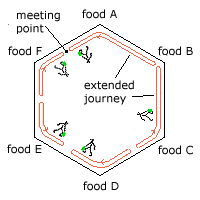 If, for example, one individual on the hexagon, at vertex B, fails to perform his expected duties in collecting food for the others, the result will be that his two neighbours will have to make extended journeys each day to get food item B. This is an extra 3 km to walk each day for the individuals at vertices A and C, which increases their walking time from 6 hours to 9 hours per day. These individuals must also each collect an additional 3 items of food at vertex B, which is another 1.5 hours of work. They must now work for 13.5 hours per day, rather than 9 hours, and their idleness falls from 0.625 to 0.44. The failure of any individual to carry out required or expected work will cost his neighbours 4.5 hours of extra work a day to make up for the omission. They might well demand that he make good this loss by repaying them the extra work he made them do, by carrying out work on their behalf.
If, for example, one individual on the hexagon, at vertex B, fails to perform his expected duties in collecting food for the others, the result will be that his two neighbours will have to make extended journeys each day to get food item B. This is an extra 3 km to walk each day for the individuals at vertices A and C, which increases their walking time from 6 hours to 9 hours per day. These individuals must also each collect an additional 3 items of food at vertex B, which is another 1.5 hours of work. They must now work for 13.5 hours per day, rather than 9 hours, and their idleness falls from 0.625 to 0.44. The failure of any individual to carry out required or expected work will cost his neighbours 4.5 hours of extra work a day to make up for the omission. They might well demand that he make good this loss by repaying them the extra work he made them do, by carrying out work on their behalf.
If their initial idleness was very much lower than 0.625, the failure of individual B to collect and distribute food B could push their idleness below zero, threatening their lives. And where the omissions of an individual threaten the lives of others, they might well punish him with death.
By this account, rules and regulations, laws, and morality, would all gradually emerge from the prevailing circumstances. And they acquire greater force with falling idleness.
5. Planned Trading Society
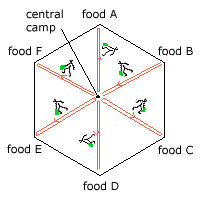 A variant of this trading system is one of having a central camp from which each individual walks to a different vertex, collects enough food for 6 people, and carries this back to the central camp to share with others. Individual idleness in this case is again 0.625.
A variant of this trading system is one of having a central camp from which each individual walks to a different vertex, collects enough food for 6 people, and carries this back to the central camp to share with others. Individual idleness in this case is again 0.625.
However, while the previous trading system may well be imagined to gradually take shape from a set of food-carrying nomads who begin to meet and trade, this latest system would appear to be one which would not naturally evolve by slow stages, but which would require planning and agreement beforehand - for it is rather hard to see how such a social organisation, with a central camp or meeting place, might spontaneously emerge by chance from the disconnected decisions of individual people.
For if a single nomadic individual were to begin to collect food from each vertex and take it to the centre of the hexagon, he would double his walking time from 18 hours per day to 36 hours per day, which is impossible. If two individuals were to each gather food from 3 vertices and bring them to the centre of the hexagon to share, it would take them each 18 hours of walking per day, which is no improvement on nomadic life. It is only when 3 individuals start to each collect from 2 vertices that the total journey time falls to 12 hours, and any sort of gain in idleness will emerge from this sort of social organisation. And so at least 3 people must be persuaded to try it out if it is to work at all, because one or two is not enough.
Equally, this proposed mode of existence entails a fairly radical departure from normal behaviour, where individuals walk between vertices where there is food, and not to the centre of the hexagon where there is none. "Why should I go there?" they might ask. "There's nothing there."
Furthermore, the individual members of this new society are being asked to operate under new rules. Each is to go each day to one vertex, and collect enough food for 6 people, and bring it back to the centre of the hexagon, to share with everyone else.
Planning might be said to be something that takes place when customary behaviour is unable to gradually evolve into new behaviour without encountering obstruction. Successful planning entails foreseeing such difficulties and acting to counter them.
6. Inequality
In all the different modes of existence so far discussed, there is an equality of outcome. All members have the same idleness. Now we will consider a variant where idleness is higher than those considered so far, but it is not distributed equally.
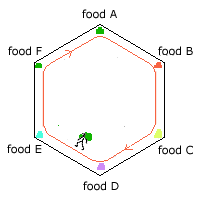 For a yet more idle variant might be to have 6 individuals collect food at 6 different vertices, and a seventh individual to go round collecting and redistributing food from each vertex. This would be a society of 6 'farmers' and one 'trader'. Individuals at each vertex would gather enough for 7 people, taking 3.5 hours. The 'trader' would go round the perimeter of the hexagon picking up produce and redistributing it equally among the other people (with himself included among these). The trader would travel around the six sides of the hexagon, a distance of 18 km, taking 18 hours. This would make for a circumstance where the 'farmers' each worked 3.5 hours per day - 85% idle -, and the trader worked 18 hours - 25% idle. The trader would be much busier than the farmers. But on average, individuals in this society would work (6 x 3.5 + 18)/7 or about 5.6 hours per day, an idleness of about 77% - an increase of 15% on the previous scheme.
For a yet more idle variant might be to have 6 individuals collect food at 6 different vertices, and a seventh individual to go round collecting and redistributing food from each vertex. This would be a society of 6 'farmers' and one 'trader'. Individuals at each vertex would gather enough for 7 people, taking 3.5 hours. The 'trader' would go round the perimeter of the hexagon picking up produce and redistributing it equally among the other people (with himself included among these). The trader would travel around the six sides of the hexagon, a distance of 18 km, taking 18 hours. This would make for a circumstance where the 'farmers' each worked 3.5 hours per day - 85% idle -, and the trader worked 18 hours - 25% idle. The trader would be much busier than the farmers. But on average, individuals in this society would work (6 x 3.5 + 18)/7 or about 5.6 hours per day, an idleness of about 77% - an increase of 15% on the previous scheme.
This raises the question of whether human societies should seek an equality of idleness, or a maximum of social idleness. This latest proposal offers the maximum social idleness, but with an extreme of inequality inherent in it. It is also an arrangement which suits 6 out of the 7 members of this society very well. And if majority rule applies, these 6 members may oblige the seventh to endure a far busier, more hard-working life than theirs - making him a slave. And the seventh member might not be able to leave this society and return to the life of a lone nomad - because such a life might no longer be viable.
But while the average idleness of this society might be 77%, themost important value of idleness is that of its least idle member - 25%. Should circumstances worsen so that his idleness fell to zero, while that of the others stayed fairly high, this member of society would be unable to carry out his trading task. Food would cease to be distributed, and the society would disintegrate. The strength of any society is that of its weakest link.
7. Population
A further consequence that appears to flow from this model of the formation of society is that the more people there are who work cooperatively in a society, the higher social idleness rises. The idleness of one nomadic individual, walking around the perimeter of the hexagon, is about 12%. Where 3 individuals each collect 2 types of food, and trade them with neighbours for other kinds of food, their idleness rises to 37%. And where 6 individuals each collect one kind of food, and trade with their neighbours, their idleness rises to 62%. There seems to be a clear case of "Many hands make light work" in operation.
One might press this further. What if 6 individuals each collect food for everyone at each vertex of the hexagon, and another 6 individuals carry their produce from one vertex to the next, making 12 individuals in total. If it is again taken that it takes one man 0.5 hours to collect enough of one food for one individual, and three hours to walk the 3 km between vertices of the hexagon, then the food collectors will be busy for 0.5 x 12, or 6 hours every day. And those who transport this food to the next vertex will take 6 hours on the round trip. Their idleness is the same, at (24-6)/24 or 75%. Idleness has risen again.
If the population is increased to 18, with one person collecting food sufficient for 10 people at each vertex, and a second carrying it 2.5 km towards to the next vertex, and a third carrying it the rest of the distance and helping to collect the rest of the food food needed for the community, the idleness of each member is the same at nearly 80%.
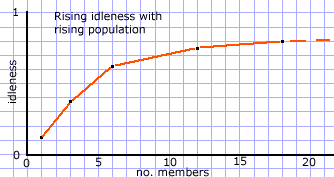 In the circumstance where the more people there are in a society, the higher its idleness rises, there is a clear incentive for societies to acquire more members. And, in the long term, the simplest way to do this is to have more children. And so settled trading societies began increasing their reproduction rates. Populations grew. And the role of women became that of child-bearers and mothers.
In the circumstance where the more people there are in a society, the higher its idleness rises, there is a clear incentive for societies to acquire more members. And, in the long term, the simplest way to do this is to have more children. And so settled trading societies began increasing their reproduction rates. Populations grew. And the role of women became that of child-bearers and mothers.
The same did not apply when humans lived an independent nomadic life. There was no incentive for nomads to increase their numbers. Living idly and entirely independently of each other, they had no use for helpers. For any nomad mother, or nomad family, the task of caring for infants would have entailed a fall in parental idleness. And so the nomads bred infrequently. And their numbers remained stable.
And if settled human societies always wanted new members, then if they could not wait for children to be raised to become working adults, they might have bought adult human labour from other societies, or captured and enslaved such adults.
Review
In the above account, humans started out living independently of each other, with individuals gathering food for themselves, in a nomadic and largely idle life. There were no rules or regulations about this life. Human interactions were intermittent and infrequent, and consequently there was no need to consider other people, or even communicate with them. Most likely there was no spoken language. There were no rules or regulations to the nomadic life, no 'right way' of living.
As their natural environment gradually (or sometimes rapidly) changed, human idleness would change with it. If food became more abundant, their idleness would rise. If it became less abundant or dispersed, their idleness would fall. When their idleness fell, humans would gradually become unable to range freely from one food source to the next, but would gradually become constrained to walking between a few food sources. They would become relatively geographically constrained. In the above geography, they would become increasingly constrained to walking around the perimeter of a hexagon, collecting and eating food along the route - because this offered the idlest mode of existence, and the best survival strategy. In so doing, they would increasingly encounter, or find themselves in company with, other humans doing the same thing. Human groups would begin to coalesce.
Humans carrying food were also sources of food. This, along with frequent meetings, made exchange possible, first occasionally and then regularly. It has been shown that there are a variety of possible patterns of exchange that result in a settled existence, and more importantly higher idleness. With increasing interactions, language became essential as never before.
None of this needs to have been deliberately planned or organised. It is something that can be achieved by gradual evolution with small changes in human behaviour. A wandering independent existence can gradually be transformed into a settled interdependent trading existence without any need for any prior social contract. Only once trading societies naturally evolved would they have been consciously and deliberately modified, and entirely new variants attempted.
As human societies emerged from nomadic life, they offered increased idleness. Gradually, nomadic life became first difficult, and then impossible, and human life could only continue in one or other variety of social organisation. But if humans gained freedom in increased idleness, they lost their former nomadic independence. They now depended on others, and others depended on them. They had expectations of others, and others had expectations of them. They had to be disciplined. As independent nomads, they had never cared what anyone else did, and did what they wanted when they chose. But in an interdependent society they cared very much how others behaved, whether they diligently carried out their customary or appointed work, or shirked their tasks and broke their promises. For the failure or omissions of one entailed costs for all.
In this manner human societies, demonstrating many of the principal features of such societies, gradually emerge from a shapeless mass of independent individuals.
- Appearance of human groups.
- Trade of one good for another.
- Increasingly settled mode of existence.
- Division of labour.
- Rising populations
- Women as primarily child-bearers
And at the same time many of the persistent vexing problems of human societies make their appearance. There is a new need for mutual consideration, dependability, and discipline that was largely absent in nomadic life. The persistent problem of inequality rears its head. And there is the problem of who makes political decisions in society, about how society is organised, and who does what.
All of this is the consequence of falling idleness. It is in response to falling idleness that human groups appear, trade, settle, and specialise. And once humans have begun trading food, and carrying large quantities of materials around, it is not hard to imagine that they should start employing useful tools like bags, ropes, carts that save them time in transporting these goods from one place to the next. And once they are making and trading such tools, they are quite likely to start making tools that speed their tool-making industry. They may start making hammers and axes and needles and drills. At each step, their idleness rose. But this perhaps served only to counteract a slow but steady fall in idleness.
Why should idleness be persistently falling? It has been possible to imagine that it rains, and the ground turns muddy, and it takes longer to walk from place to place, and idleness falls. But when the rains cease, and the ground hardens, surely idleness will rise again? But it is instead perhaps that when living creatures 'adapt' to their environment, what they are doing is to maximise their idleness. And if their idleness is already optimal, any change will automatically entail a fall in idleness. Using the example of rain, one might imagine a society which uses wheeled carts to move around on hard ground. Then it rains and the ground gets muddy, and the carts get stuck in the mud, and their idleness falls. It keeps on raining, the land becomes flooded, and their idleness falls further. And then they 'adapt' by building boats, and their idleness rises to something like its former level. But if the floods subside, their boats become as useless as their carts once became, and their idleness falls. In this manner, any sort of environmental change, whether it gets warmer or colder, or wetter or drier, will result in falling idleness. In this manner, more or less whatever happens, human idleness falls.
If however it is supposed that not all change is detrimental to idleness, and that a period of climatic change which reduced idleness was followed by a period in which idleness rose, then the entire process of forming societies would go into reverse. There would still be small gains in idleness to be had from a social mode of existence, but the need for it would lessen. Cooperative human societies would divide and gradually disintegrate until everyone had reverted to an independent nomadic life again. There is nothing in this account of the origin of human society which says that a social mode of existence is in any sense historically inevitable. It simply happens to be convenient in some circumstances. It is entirely plausible that, now that human numbers have risen to 6 billion, that they might dwindle away again to a few thousand, who had reverted to a nomadic existence on a newly forested planet. Neither is it implausible that human societies may have formed and disintegrated many times.
The above essay entails many assumptions, both explicit and implicit. It also uses some numbers grabbed from thin air - half an hour to collect food for one person at each vertex, 1 km/hr walking speed. Would its logic still hold if these numbers were different?
One implicit assumption is that trading food takes no time at all. This only plausible if trade entailed people exchanging what they were carrying. The other possibility is that they could spend a long time haggling over what should be exchanged for what.
